Difference between revisions of "Thrusters"
(Thruster usage values reverted after further testing. Values were correct. Reduction in electricity usage casused by not having electricity converter is a bug.) |
m (→Basic information: minor corrections + links) |
||
| Line 28: | Line 28: | ||
** Box and triangle thrusters are big "main" thrusters and consist of multiple parts that need to be bolted together. | ** Box and triangle thrusters are big "main" thrusters and consist of multiple parts that need to be bolted together. | ||
** Maneuver thrusters enable small movements of the ship such as adjusting yaw and pitch, though they can still be used as main thrusters on smaller ships. | ** Maneuver thrusters enable small movements of the ship such as adjusting yaw and pitch, though they can still be used as main thrusters on smaller ships. | ||
** Thrusters need to be [[Bolt tool|bolted]] to a | ** Thrusters need to be [[Bolt tool|bolted]] to a [[Hardpoints|Hardpoint]] that has access to propellant and electricity. | ||
* Thrusters need to be in the same [[Data networks|data network]] as the FCU [[Flight control unit | * Thrusters need to be in the same [[Data networks|data network]] as the FCU [[Flight control unit]] and MFC [[Main flight computer]], if they are to be controled by the MFC. | ||
* Thrusters require power to function. | * Thrusters require power to function. | ||
** To get power, a [[Cable tool|cable]] has to be drawn from a power source, such as a [[Generator]] or [[Battery]] to the | ** To get power, a [[Cable tool|cable]] has to be drawn from a power source, such as a [[Generator]] or [[Battery]] to the [[Hardpoints|Hardpoint]]'s socket. | ||
* A thruster also requires [[Propellant|propellant]] to function. | * A thruster also requires [[Propellant|propellant]] to function. | ||
** To get propellant, a [[Pipe tool|pipe]] has to be drawn between the device hardpoint and a gas container. | ** To get propellant, a [[Pipe tool|pipe]] has to be drawn between the device hardpoint and a gas container. | ||
== Thruster types == | == Thruster types == | ||
Revision as of 22:18, 4 January 2021
Summary
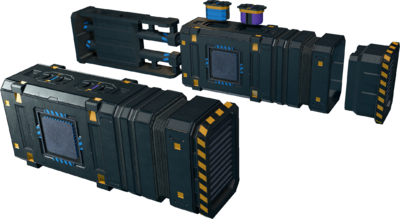
Thrusters are a mandatory part of spaceships in order for them to be able to fly. At least one thruster is required in each ship.
Use
Thrusters determine which directions spaceships can be flown and at what speed, and they require power and propellant to function.
A cable drawn from the power source must be attached to the base of the thruster for correct distribution of power.
- There are three different thruster types available:
- Box thrusters
- Triangle thrusters
- Maneuver thrusters
Basic information
- To be able to fly, a spaceship needs at least a one thruster.
- Box and triangle thrusters are big "main" thrusters and consist of multiple parts that need to be bolted together.
- Maneuver thrusters enable small movements of the ship such as adjusting yaw and pitch, though they can still be used as main thrusters on smaller ships.
- Thrusters need to be bolted to a Hardpoint that has access to propellant and electricity.
- Thrusters need to be in the same data network as the FCU Flight control unit and MFC Main flight computer, if they are to be controled by the MFC.
- Thrusters require power to function.
- A thruster also requires propellant to function.
- To get propellant, a pipe has to be drawn between the device hardpoint and a gas container.
Thruster types
Box thruster

Box Thrusters with regular and corner base variants.
- Box thrusters provide 500 000 thrust
- At maximum thrust Box thrusters use 23.3 propellant per second and 140 electricity per second.
Triangle thruster
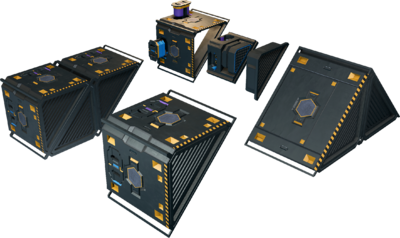
Triangle thrusters. The sides with a hexagon on them can be used to stack multiple thrusters to one base.
- Triangle thrusters provide 300 000 thrust
- At maximum thrust Triangle thrusters use 35 propellant per second and 17.5 electricity per second.
Maneuver thruster
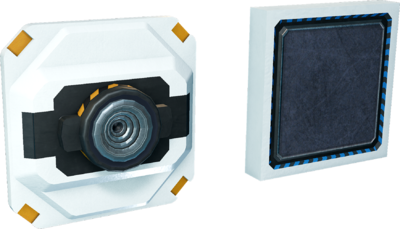
Small thrusters meant for maneuvering the ship.
- Maneuver thrusters provide 50 000 thrust
- At maximum thrust Maneuver thrusters use 11.7 propellant per second and 5 electricity per second.
Resource efficiency
Graphs showing thruster resource efficiencies per thrust level, electricity per second (eps) in blue and propellant per second (pps) in orange.
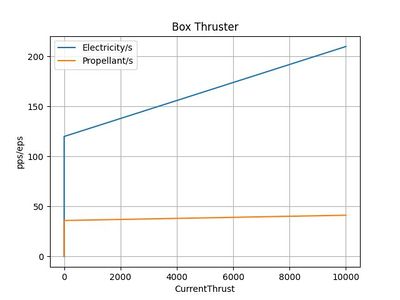
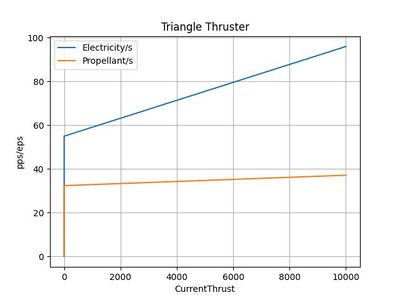
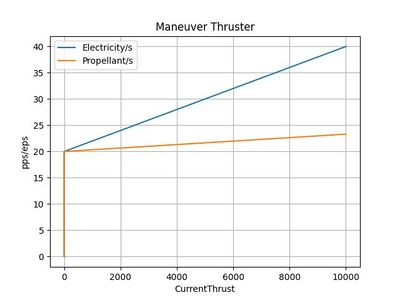
Device fields
To learn more about how to use fields, consult these wiki pages:
| YOLOL field | description | range |
|---|---|---|
| ThrusterState | Requested output of the thruster | 0 - 10 000 |
| ThrusterCurrentThrust | Current output of the thruster | 0 - 10 000 |